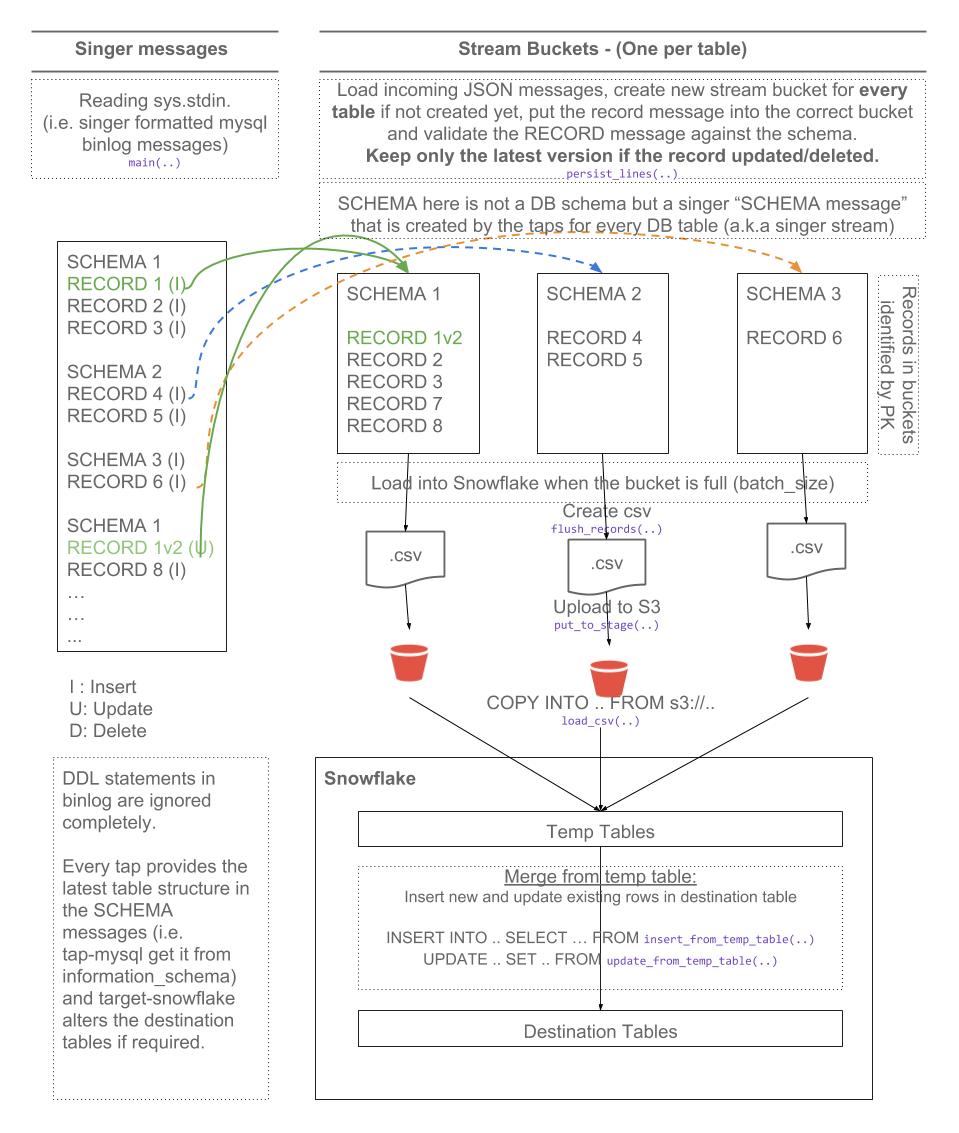Singer target that loads data into Snowflake following the Singer spec.
This repository doesn't contain the code itself because that has not been open sourced (yet). If you are interested please contact to the owner of this repository at https://transferwise.com
Like any other target that's following the singer specificiation:
some-singer-tap | target-snowflake --config [config.json]
It's reading incoming messages from STDIN and using the properites in config.json to upload data into Snowflake
Settings are stored in a config.json JSON and in a map
| Property | Type | Required? | Description |
|---|---|---|---|
| account | String | Yes | Snowflake account name (i.e. rtXXXXX.eu-central-1) |
| dbname | String | Yes | Snowflake Database name |
| user | String | Yes | Snowflake User |
| password | String | Yes | Snowflake Password |
| warehouse | String | Yes | Snowflake virtual warehouse name |
| aws_access_key_id | String | Yes | S3 Access Key Id |
| aws_secret_access_key | String | Yes | S3 Secret Access Key |
| s3_bucket | String | Yes | S3 Bucket name |
| s3_key_prefix | String | (Default: None) A static prefix before the generated S3 key names. Using prefixes you can upload files into specific directories in the S3 bucket. | |
| batch_size | Integer | (Default: 100000) Maximum number of rows in each batch. At the end of each batch, the rows in the batch are loaded into Snowflake. | |
| schema | String | Name of the schema where the tables will be created | |
| dynamic_schema_name | Boolean | (Default: False) When it's true, the schema names will be created automatically derived from the incoming stream name | |
| dynamic_schema_name_postfix | String | (Default: None) Can be use together with the dynamic_schema_name option to add an optional postfix to the end of the generated schema name |
|
| grant_select_to | String or List of String | (Default: None) Grant USAGE privilege on newly created schemas and grant SELECT privilege on new created tables to a specific role or a list of roles. | |
| disable_table_cache | Boolean | (Default: False) By default the connector caches the available table structures in Snowflake at startup. In this way it doesn't need to run additional queries when ingesting data to check if altering the target tables is required. With disable_table_cache option you can turn off this caching. You will always see the most recent table structures but will cause an extra query runtime. |
|
| client_side_encryption_master_key | String | (Default: None) When this is defined, Client-Side Encryption is enabled. The data in S3 will be encrypted, No third parties, including Amazon AWS and any ISPs, can see data in the clear. Snowflake COPY command will decrypt the data once it's in Snowflake. The master key must be 256-bit length and must be encoded as base64 string. | |
| client_side_encryption_stage_object | String | (Default: None) Required when client_side_encryption_master_key is defined. The name of the encrypted stage object in Snowflake that created separately and using the same encryption master key. |
|
| add_metadata_columns | Boolean | (Default: False) Metadata columns add extra row level information about data ingestions, (i.e. when was the row read in source, when was inserted or deleted in snowflake etc.) Metadata columns are creating automatically by adding extra columns to the tables with a column prefix _SDC_. The column names are following the stitch naming conventions documented at https://www.stitchdata.com/docs/data-structure/integration-schemas#sdc-columns. Enabling metadata columns will flag the deleted rows by setting the _SDC_DELETED_AT metadata column. Without the add_metadata_columns option the deleted rows from singer taps will not be recongisable in Snowflake. |
|
| hard_delete | Boolean | (Default: False) When hard_delete option is true then DELETE SQL commands will be performed in Snowflake to delete rows in tables. It's achieved by continuously checking the _SDC_DELETED_AT metadata column sent by the singer tap. Due to deleting rows requires metadata columns, hard_delete option automatically enables the add_metadata_columns option as well. |
- Define environment variables that requires running the tests
export TARGET_SNOWFLAKE_ACCOUNT=<snowflake-account-name>
export TARGET_SNOWFLAKE_DBNAME=<snowflake-database-name>
export TARGET_SNOWFLAKE_USER=<snowflake-user>
export TARGET_SNOWFLAKE_PASSWORD=<snowfale-password>
export TARGET_SNOWFLAKE_WAREHOUSE=<snowflake-warehouse>
export TARGET_SNOWFLAKE_SCHEMA=<snowflake-schema>
export TARGET_SNOWFLAKE_AWS_ACCESS_KEY=<aws-access-key-id>
export TARGET_SNOWFLAKE_AWS_SECRET_ACCESS_KEY=<aws-access-secret-access-key>
export TARGET_SNOWFLAKE_S3_BUCKET=<s3-external-bucket>
export TARGET_SNOWFLAKE_S3_KEY_PREFIX=<bucket-directory>
export CLIENT_SIDE_ENCRYPTION_MASTER_KEY=<client_side_encryption_master_key>
export CLIENT_SIDE_ENCRYPTION_STAGE_OBJECT=<client_side_encryption_stage_object>
- Install python dependencies in a virtual env and run nose unit and integration tests
python3 -m venv venv
. venv/bin/activate
cd singer-connectors/target-snowflake
pip install --upgrade pip
pip install .
pip install nose
- To run unit tests:
nosetests --where=tests/unit
- To run integration tests:
nosetests --where=tests/integration
- Install python dependencies and run python linter
python3 -m venv venv
. venv/bin/activate
cd singer-connectors/target-snowflake
pip install --upgrade pip
pip install .
pip install pylint
pylint target_snowflake -d C,W,unexpected-keyword-arg,duplicate-code
